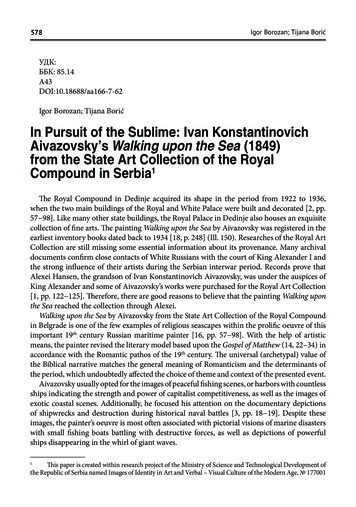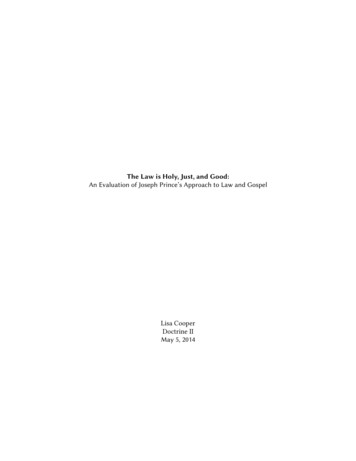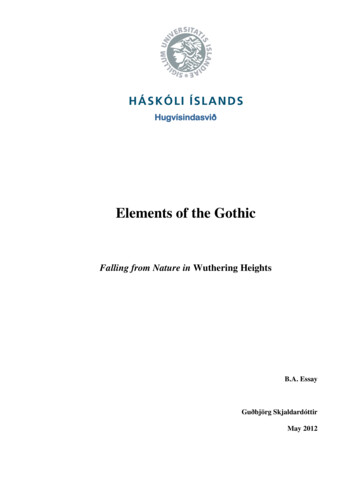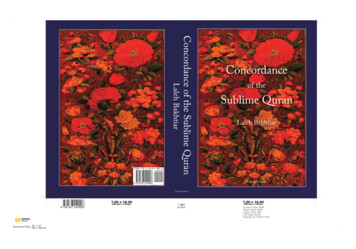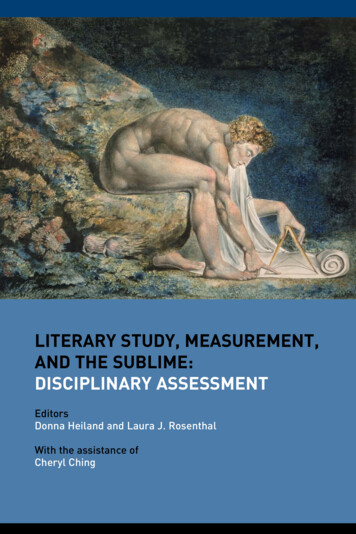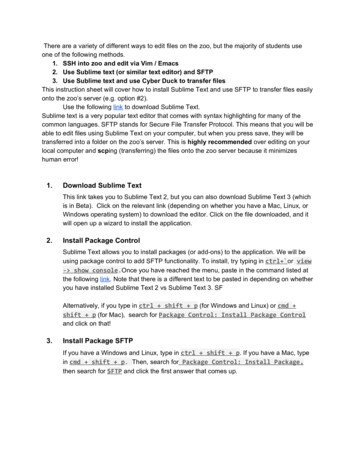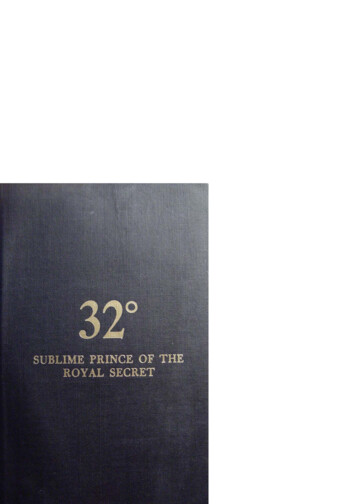
Transcription
THIRTY-SECOND DECREESublime Prince of theRoyal SecretSI (1
rrTHIRTY-SECOND DEGREESublime Prince of theRoyal SecretTHE THIRTY-SECOND DECREE OF THEANCIENT ACCEPTED SCOTTISH RITEOF FREEMASONRY, AND THEFOURTEENTH CONFERREDIN A CONSISTORY OFSUBLIME PRINCESOF THEROYAL SECRET1981This book is the property of the SUPREME COUNCIL OF SovEREIGN GRAND INSPECTORS GENERAL OF THE THIRTY-THIRD ANDLASTDEGREEOFTHEANCIENT ACCEPTEDSCOTTISHRITEOFFREEMASONRY FOR THE NORTHERN MASONIC JURISDICTION OF THEUNITED STATESOF AMERICA.When no longer needed for the exemplification of the degree,it must be returned to the Secretary.In any event, this ritual must be returned to or accounted forby the Secretary of the Consistory each year, prior to the annualmeeting.If the holder loses possession by death or otherwise, thefinder will please return to:I4GRAND SECRETARY GENERALSupreme Council, 330P.O. Box 519Lexington, Massachusetts 02173
HISTORICAL NOTESI. THE DEVELOPMENT OF THE RITUAL1. The Thirty-second Degree of the Ancient Accepted Scottish Rite stems from the Twenty-fifth and ]ast Degree of the Riteof Perfection. The title of that degree suggests its ]ater development: “Most Illustrious Sovereign Prince of Masonry, GrandKnight, Sublime Commander of the Royal Secret.” It may besaid, with reasonable historical accuracy, that the basic elementsof the Thirty-second Degree—the symbolism of the Camp, thesigns and words, and the motto “Spes mea in Deo est’ may betraced back to 1758 and to the Emperols of the East and West—a Masonic council in France which assumed full control over allso-called higher degrees.2. The Rite of Perfection of twenty-five degiees was bioughtto San Domingo by Stephen Morin, probably in 1763. In ICingston, Jamaica, a few years later—between 1767-1800—-it was expanded into a Rite of thirty-three degrees and the 250 of theRite of Perfection became the 320 of what was to be known asthe Ancient and Accepted Scottish Rite.I3. The earliest available ritual of this degree is in the manuscript rituals of the Rite of Perfection, 40 250, which HenryAndrew Francken eceived from Stephen Morin and copied, inEnglish, in 1783. The original of this Francken Manuscript is inthe Archives of the Supreme Council, 330, A. .A. .S. ‘.R. for theNorthern Masonic Jurisdiction, U.S.A.The title of the 250 of the Rite of Perfection in the Franckeniitual is “Royal Secret, or the Knights of St. Andrew and theFaithful Guardians of the Sacred Treasure. Ne Plus Ultra.”Each member was called a “Sublime Prince of the Royal Secret”which, later, became the official title of the Thirty-second degree.‘ThereanoxcollcntIs nodegrees.ritualwater-colortext,the Campof mottotheis �cccdfngSigns,butdrawingwordsandare theas usedIn the Current litulil of the 320.5
r64. In the early days of the Scottish Rite, between 1801 and1845, there were few rituals. Degrees were communicated bytitle and secret work. The first conventional ritual of the 320appeared after 1845 in an undated manuscript copied byIll.’.Killian H. Van Rensselaei, 330 It contains elements of the300 and 310 not yet printed in separate rituals, and the 320section includes a march of the “Grand Army of Princes of theRoyal Secret,” the capture of the neophyte by the Moslems, hisrescue by the Knights Temp]ar, and a “Charge” by ll]. .GilesFonda Yates, 3305. In 1866-67, there was a critical and intelligent ievision ofthe 320 ritual—a military degree, precise, crisp, impressive, butexcluding the dramatic scene found in previous rituals. In 1875,the drama was restored, but the rescue in the battle scene was bythe uniformed “Grand Masonic Army of Sublime Princes of theRoyal Secret.” The 320 was now firmly established as the militaiydegree of the Scottish Rite, and an elaborate Consistory uniformwas prescribed in 1877 which iS still in optional use in someConsistories.6. The abuse of the military incident and the intioduction of“rude and objectionable features” led to several diaft revisionsbetween 1887 and 1911. Ill.John Lloyd Thomas, 330 (Honnlary)of New York produced a stately ritual, without drama, but retaining the symbolism of the Camp with a greatly improved textThis was adopted as a tentative ritual in 1912.7. The discussion of the 320 continued, due to a desire forthe lestoration of drama, In 1916, Ill.’.John Lloyd Thomas, 330then an Active Member of the Supreme Council for New York,prepared another ritual which Is still In force as the authorixedritual of the degree. After a brief ritualistic opening of theConsistoiy, there is a Ceremonial SectIon with a condensed symbolism of the Camp, representing Scottish Rite Bodies and notthe individual degrees, the traditional obligation, investiture andsecret work and a stirring call to Patllotism. This is followedby an Allegory which portrays the vigil of an aspirant for knighthood, his temptations, his spiritual victory, his supreme sacrifice—L.(Thirty-second DegreeSublime Prince of the Royal Secret7and his incamation of the Royal Seciet. This ritual was reprintedin 1934 without substantive change.S8. The ritual of 1950 is anothei reprint of the ritual of 1916,with a few minor changes. The new introductory pages includehistorical notes on the development of the ritual of the Thirtysecond Degree; a definition of an allegory; and an interpretationof the allegorical characters in the degree.A routine paragiaph in the Obligation has been omitted toprovide fnr the insertion of part of an old obligation which ranksamong the noblest in Fieemasonry—a paragi aph on the unity ofFreemasonry, adopted by The Union of 1867, deleted in 1875 forsome unknown reason, and now restored to its place in the degree.4)49. The Ritual of 1978 makes very few changes but is anattempt to modernixe the Degree, while retaining all of thebeauty of the original. Constans’ soliloquy over his armor, approved for optional use in 1966, is now included. A portion ofthe Prince Commander’s speeches has been given to the Bishop,where they appropriately belong. Other minor changes improvethe pace of the action.The official and formal closing ceremonies contained in theprevious Ritual ale omitted. This Degmee should be the climaxof all that has gone befoie, hence, the Consistory should beclosed while the lesson of the allegory remains uppermost in theheaits and minds of the candidates.[I. THE HOLY EMPIREOn the flap of the 320 Apron is a double-headed eagle “supported hy the flags of the Holy Empire,” and, until 1934, theletters II E. were attached to the titles of Grand SecretaryGeneral ,uid Giand Tieasuier General.Rescaich has not yet disclosed the oligin of the term “HolyEmpire” or its meaning, though the question continues. It is possihle that the term originated in 1758 with the Emperors of theEast and West. The “Holy Empire” over which this Council
r8Thirty-second Degreeexercised Masonic authority was not a territorial jurisdiction, butan empire of philosophy and morals in the twenty-five degrees ofthe Rite of Perfection.I1Sublime Prince of the Royal Secret(Ill. .Albert Pike, 330 in Morals and Dogma, favored an esoteric interpretation. “The true Royal Secret which makes possible shall at last make seal—the Holy Empire of true MasonicBrotherhood.” (Page 861) It is defined as the victory of thespiritual over the human in men, the conquest of appetites andpassions by the moral sense and reason. (Page 855)9FOR THE INFORMATION OF OFFICERS1. TheCeremonialSectionoftheThirty-secondDegreeshould be conferred by the regularly elected and appointedofficers of the Consistory. This is their prerogative and their duty,and Consistories are ui ged to choose officers qualified for theirritualistic tasks.2. It is the privilege of the Commander-in-Chief to reassignritual parts in the Ceremonial Section, so that each officer may dothe work for which he is best fitted.3. Innovations and non-ritualistic interpolations in the Ceremonial Section and the Allegory are not permitted.4. The proper salute for Consistorial work, with the exception of sword salute, is given by placing the right hand over theheart, fingers and thumb together and joined, then extend theaim horizontally, palm down; and then drop the hand to the side.5. Attention is directed to the definition of an allegory andthe interpretation of the allegorical characters of the Thirtysecond Degree. See page 14. It is of the utmost importancethat this section be read to the cast of the Allegory at the firstrehearsal.46 Those responsible for the selection of the cast of the Allegory are uiged to choose degree workers whose age, personalityand training fit them for the assigned parts. It is especially important that CONSTANS should be neither effeminate, nor too oldfor an aspirant for knighthood. He is conceived as a vigorous mili-taiy type, isot more than 30 yeais of age, deeplyin earnest andnot ovel -emotional7. Please insert in official program “During the Allegory,the cuitain will be closed, and all lights extinguished for 30seconds—to denote the passing of several hours.”h.
r10Thirty-second DegreetSublime Prince of the Royal Secret11CEREMONIAL SECTIONCOSTUMESNo mandatory regulation. All who participate in theCeremonial Section may wear—1. Full evening dress or tuxedo—with the collar ofthe 320. Jewel of office optiona].or2. Official costumes of their respective offices.or3. Regu]ation Consistory uniform.COLLAR: Black silk ribbon edged with silver lace.At the point a red Teutonic cross surmounted by a silverdouble-headed eagle embroidered in silk and bullion.Collar lined with scarlet silk with a black silk embroidered Teutonic cross at the point.JEWEL: A Teutonic cross of heavily gold-platedmetal on which rests a double-headed eagle—half blackand half white.APRON: White, grosgrain silk or satin, bordered withblack silk and lined with black. On the flap—an Allseeing Eye and a Teutonic cross and a double-headedeagle, with three symbolic flags on each side. In themiddle of the apron is the Camp.PERSONNELThe Officers of the ConsistoryCommander-in-ChiefFirst Lieut. CommanderSecond Lieut. CommanderOratorHospitalerChancellorEngineer and SeneschalTreasurerStandard Bearers (2)SecretaryCaptain of the CuardMaster of CeremoniesSentinelOfficersPresiding officers only may be used, if desiied.Ancient Craft LodgeWorshipful MasterSenior WardenJunior WardenLodge of PerfectionThrice Potent MasterDeputy MasterSenior WardenJunior WardenCouncil of Princes of JerusalemSovereign PrinceHigh PriestSenior WardenJunior WardenChapter of Rose CroixMost Wise MasterSenior WardenJunior WardenOratorChancellor of Knights KadoshConstans SpursPROPERTIESPedestal and CavelAltar: With open Bible and SwordCordonTeutonic CrossApron
r12IThirty-second DegreeSublime Prince of the Royal SecretTHE ALLEGORYCast of istersChivalryTrumpeterHeraldKnightsPrince CommanderKnight of Rose CroixKnight KadoshKnight, Crand Elect MasonKnight, Prince of JerusalemConstansFlorioUrbanRufus, a family servantIgnatiusCaptain of the CuardPopulaceCostumesCHURCHTraditional ecclesiastical costumes (Note: There isno Cardinal in this procession.)CHIVALRYHerald and Trumpeter: N4edieval dressSponsors: Knight’s uniformPrince Commander, Captain of the Cuard, andKnights: Crusader’s uniformL.C13Constans: White robe with white cape if desired.Should be played as a young man not morethan thirty years of age. Avoid casting olderman for this part.Florio: Fancy festival costume; carries domino andmask.Urban: Philosopher’s i-obe with long white wig andbeardRufus: Rural working clothesIgnatius: Monk’s i-obe, rope girdle, cowl, tonsure,CrucifixPoPuiAcEWide variety of period costumes, 1-epresenting occupation and station in life.Note—The populace should be properly costumed.
r14Sublime Prince of the Royal SecretThirty-second DegreeTHE ALLEGORY1.(BisHop: A symbol of the influence of Religion in aman’s inner struggle with temptation.PLUNGE COMMANDER:DEFINITIONAn allegory is a veiled and figurative presentation oftruth in which the characters speak, not for themselvesas individuals, but for what they represent. It may behistorical like Faerie Queene by Edmund Spenser(1590) or moral and spiritual like Pilgrim’s Progressby John Bunyan (1678).2.SPONsORS: The qualities of the true Knight—Fidelity, Truth, Love, Justice and Mercy.FLoRIo:The Lure of Pleasure.URBAN:The Power of Knowledge.Rurus: The Appeal of Self-interest.The False Security of the Monastic Life.CAPTAIN OF THE CUARD: The world’s approval ofself-forgetful and sacrificial service.TaRROYAL SECRET:NOTE: NoINTERPRETATIONRepresents every Freemason of the Ancient Accepted Scottish Rite, eager to serve Humanitybut caught between self-interest and the call of duty.CONSTANS:IE IEhIhII IIUULove.additional characters should be added.Each character in the Allegory represents an element in the moral and spiritual aspect of the struggleit portrays:L.The Voice of Duty.TruIGNATIus:The Allegory of the Thirty-second Degree portraysa moral and spiritual conflict and, though it is exemplified in a dramatic form, it has no historical significance.The Age of Chivalry lends itself to the purpose of theAllegory which belongs to no specific time or place. Thispermits the use of concepts, ritual phrases, action andmusic which would be anachronisms in a definite historical setting. The sequences emphasize the literary unityand simplicity of the text, and attract attention to thespiritual lesson of the Allegory.15
rSublime Prince of the Royal SecretCommander-in-Chief—SeparatedOPENING CEREMONYyetUnited.17Somust it be until we end our campaign and dwell in perfect peace. To order, Princes. {O.fi Officers salute withCandidates shall be admitted and seated before theOpening.Martial music. Officers of Consistory march to stations.If action is on the stage, curtain rises and disclosesofficers in place.Commander-in-Chief— If there be any present,with the exception of candidates, who are not SublimePrinces of the Royal Secret, let them depart in peace,that our Consistory may be secure. Captain of theCuard, see to the approaches, that none profane maydraw nigh. Engineer and Seneschal, draw the lines ofour Masonic camp and see that we are secure againststealthy intrusion or sudden attack.Captain of the Guard—Commander-in-Chief, yourorder shall be obeyed.Captain of the Guatd salutes.Engineer and Senescha] advances and makes roundof camp and receives report from Captain ol the Guard,after which, at west of camp, salutesEngineer and Seneschal—Commander-in-Chief, thelines and bounds of our camp are set. The Cuards areposted. Our Consistory is secure.Commander-in-Chief—It is well. What are the passwords of our camp?Engineer and Seneschal—PHA-AL-CHOL: PHARASCH-CHOL. (Pronounced Fay-all-call and Fay-rashcall)the battery. We cherish here that which isgood, (Hand on heart) we repel that which is evil (Extend arm to front, palm down); and in all our Jabors andconflicts we shall say (Hand on heart) “Spes mea (Extend hand to front, palm down) in Deo est.” As our hopeis in Cod, the Orator will lead our devotions.Officers remain standing on the Sign of Fidelity. Headsbowed. Orator advances to Altar. Kneels.Orator—O Cod, our Father, we bless Thee for ourdaily work and for the strength which Thou dost bestow. We thank Thee for the giving which makes usricher; for the service which make us stronger; for thediscipline which purifies; for the trials which give uscourage; and for the call of humanity which joins manwith Thee in the work of the world.We thank Thee for the Past, because it laid thefoundation of all good; for the Future, which gives us avision of better things to be; but most of all do we thankThee for the Present, with its needs and its inspirations,with its opportunities and its powers; with its servicewhich is joy, and its love which crowns our labors witheternal life.Our Hope is in Cod, and in that Hope we pray:Here the Lord’s Prayer should either be spoken or sung.-16L.Our Father, who art in heaven, Hallowed be thyName. Thy kingdom come. Thy will be done, on earth
r18Thirty-second Degreeas it is in heaven. Cive us this day our daily bread, andforgive us our trespasses, as we forgive those who trespass against us. And lead us not into temptation, butdeliver us from evil. For thine is the kingdom, and thepower, and the glory, for ever and ever. Amen.Commander-in-Chief—To the glory of the CrandArchitect of the Universe; in the name and under theauspices of the Supreme Council of Sovereign CrandInspectors Ceneral of the Thirty-third and last degreeof the Ancient Accepted Scottish Rite of Freemasonryfor the Northern Masonic Jurisdiction of the UnitedStates of America, and by virtue of the authority uponme conferred, I declare the works ofConsistory opened on the Thirty-second Degree. (All seated.)CEREMONIAL SECTIONCommander-in-Chief—Princes, we meet here inpeace, but the call of the world ceaselessly disturbs ourquiet. The needs of Humanity are insistent and we darenot ignore them. Fain would I believe that we respondfaithfully to every call, but we know the disloyalty thatlurks in idleness, the treachery that abides in sloth. Remember, therefore, that we are encamped in the midstof alarms, ever subject to attack from the strong, everresponsive to the call of the weal . First LieutenantCommander, what is the hour?First Lieutenant-Commander—Time was; time is;but no man may say that time shall be. For the SublimePrince of the Royal Secret, therefore, the hour is always—NOW.Alarm at door—distinctly— Commander-in-Chief—Even now, our call to dutyhas sounded. Let us hasten to answer ere it is too late.Captain of the Cuard, open wide the door, that he whoknocl s may enter freely. Master of Ceremonies, receivehim as an honored guest, for he brings us the rich giftof opportunity.Captain of the Guard opens the door and Constans,representing candidate, enters.Master of Ceremonies—(Midway between the Commander-in-Chief and the door) Welcome, my Brother, tothis Consistory of Sublime Princes of the Royal Secret.If you are a suppliant, you bring us opportunity to serve.19L.G EIIII IGIO
rThirty-second Degree20If you are an ally, you may serve with us. Advance withconfidence and our Commander-in-Chief will hear you.WELCOME ODE (optional)CHOIR—Thrice welcome we give to the Brother whose heartWith the heart of Mankind is akin.Thrice welcome to all who would do a man’s partIn the war against error and sin.For him our doors are opened wideFor him our love, what’er betide,Thrice welcome we give to the Brother whose heartWith the heart of Mankind is akin.Masterof Ceremonies takes Constans by left arm, conducts him to west of camp and returns to his place.Constans—Commander-in-Chief, a suppliant I come,that I may also be an ally. I know that none should beadmitted to your ranks save earnest and sincere men,—Masons, not in name only, but also in deed. I am earnest and sincere, a Mason, and a Grand Inspector Inquisitor Commander of the Ancient Accepted ScottishRite. I know full well my unworthiness, yet I humblyaspire to serve with you for the good of our brothermen.The following colloquy should be slow, solemn andsincere.Commander-in-Chief—By what name are youcalled?Constans—Constans. (Cofi-stan )Commander-in-Chief—What do you desire?Constans—To be admitted among you as a fellowsoldier and servant in the Grand Masonic Army of Sublime Princes of the Royal Secret.h.Sublime Prince of the Royal SecretCommander-in-Chief—Why a soldier?21Constans—That I may shield the oppressed; guardthe weak; protect the innocent; and combat the cncmies of God and humanity.Commander-in-Chief—Why a servant?Constans—That I may help the needy; succor thepoor; relieve the distressed; and be a builder and trueMason in the holy House of the Temple.Commander-in-Chief—You ask much, for you askto be a co-worker with God. How have you preparedyourself for this high employ?Constans—It is not for me to speak. Unless myBrethren can answer for me, I am indeed unworthy.Master of Ceremonies—Commander-in-Chief, I vouchfor the Masonic progress of this Brother. He has beenregularly initiated as an Entered Apprentice; passed tothe degree of Fellow Craft; and raised to the SublimeDegree of Master Mason. He has been chosen a GrandElect Mason, proclaimed a Prince of Jerusalem, consecrated a Knight of Rose Croix, and promoted to the rankof Grand Inspector Inquisitor Commander.Commander-in-Chief—Your progress has been steady;yet all this does not suffice if you have not studied andunderstood the lessons taught, and the principles inculcated in these degrees. Behold the lines of our Masonic camp spread before your view, and be tried by itsdiscipline and tests.The Consistory will choose its own techniques andwork in interpreting the angles of the pentagon.floor
r22Sublime Prince of the Royal SecretEngineer and Seneschal rises and salutes.that this Brother has been raised to I he Sublime Degreeof Master Mason, has dedicated himself at the Altar ofMasonry, and has been inspired by the Master’s word.He is a worthy Master Mason.Engineer and Seneschal—The camp of the AncientAccepted Scottish Rite of Freemasonry is a nonagon enclosing a heptagon, within whose lines is a pentagonwhich encloses a triangle in the center of which is acircle. Thus do we find the mystic numbers, 3, 5, 7 and9, all emanating from the circle of infinity. As thesenumbers symbolize Divine attributes and Masonic principles, so should Masonic labor emanate from Divinelove, be directed by Divine wisdom, and be exercisedin Divine power for the good of mankind and the gloryof God.The second emanation from infinity is denoted bythe pentagon, each angle of which represents a divisionof the Scottish Rite Army. Take heed while their attributes are now rehearsed.Engineer and Seneschal salutes and returns to station.Orator rises and salutes.Orator—The first angle represents the SymbolicLodge wherein are given the first lessons in Masonry.The Entered Apprentice is the physical man admonished to labor; The Fellow Craft is the intellectual manin whom knowledge is joined to physical power as science directs energy; the Master Mason is the triuneman, in whom the spiritual is united with the intellectual and the physical, and whose works are eternal,because eternal love inspires intelligent labor.The Worshipful Master may be attended by his twoWardens. They rise, and the Master salutes.Worshipful Master—Commander-in-Chief, I here declare as a Worshipful Master in Ancient Craft Masonry,L.23Thirty-second DegreeOrator and Worshipful Master salute and are seated.Hospitaler rises and salutes.Hospitaler—The second angle represents the Lodgeof Perfection. Herein are taught those duties toward ourbrother man whose performance leads steadily toward aknowledge of God. We learn that selfish endeavor defeats itself and debases the man who engages in it. Weare taught that by united labor for the good of all, humanity is advanced toward the Ineffable Mystery wherein all should be perfect.Thrice Potent Master may be attended by Isis DeputyMaster, SeniorandJunior Wardens. They rise and theT.P.M. salutes.Thrice Potent Master—Commander-in-Chief, I heredeclare as Thrice Potent Master of a Lodge of Perfection, Ancient Accepted Scottish Rite, that this Brotherhas labored for the uphuilding of the temple; he hasguarded its treasures, and delved into its mysteries. Rehas studied the Ineffable Symbols, and has learned theIneffable Word. He is a Grand Elect Mason.Hospitaler and T.P.M. salute and are seated. Orator risesand salutes.Orator—The third angle represents the Council ofPrinces of Jerusalem. Here is taught the power of Truthto release the captive of error, and to rebuild the templeof human happiness when assailed by ignorance andvice from within, or by injustice and oppression from
r24Thirty-second Degreewithout. Fidelity to trust, honesty in public and privateconduct, devotion to Truth, are the attributes of a Princeof Jerusalem.The Sovereign Prince may be attended by his HighPriest, Senior and Junior Wardens. They rise. The Sovereign Prince salutes.I3Sovereign Prince—Commander-in-Chief, I here declare as Sovereign Prince of a Council of Princes ofJerusalem, Ancient Accepted Scottish Rite, that thisBrother has withstood temptation and has kept his trust.He has labored with the sword of vigilance in one hand,and the trowel of steadfast purpose in the other. He isa Prince of Jerusalem.L25Second Lieutenant-Commander and M.W.M. salute andare seated. First Lieutenant-Commander rises and salutes.First Lieutenant-Commander—The fifth angle represents the Kadosh. By impressive ceremonies have beentaught the lessons that the future is heir to the prescnt;that the light of Masonry should illumine the darkncssof the world; that labor is noble; that all worship is holywhen prompted by a devout heart, that Cod is foundthrough service to men; that from Cod comes all goodand to Cod all good should return in loving oblation.Finally, that as all men are sons of God, so should menbe brethren working together for good.Chancellor rises and salutesOrator and Sovereign Prince salute and are seated.Second Lieutenant-Commander rises and salutes.Second Lieutenant-Commander—The fourth anglerepresents the Chapter of Knights Rose CroiK. Here thelight promised to man from ancient times shines in allits glory. The love which gives eternal life is revealed.Faith, Elope and Charity are the pillars of the spiritualtemple. The new law is proclaimed, and men learn to“Love one another.”The Most Wise Master may be attendccl by his Seniorand Junior Waidens. They rise. The M.W.M. salutes.Most Wise Master—Commander-in-Chief, I here declare as Most Wise Master of a Chapter of Rose Croix,Ancient Accepted Scottish Rite, that this Brother has followed the Light. He has learned the new law. He knowsthat good will overcome evil; that life eternal will conquer death; that through love, our brotherhood is everlasting. He is a Knight Rose Croix.Sublime Prince of the Royal SecretChancellor—Commander- in-Chief, I here declare asChancellor of Knights Kadosh, Ancient Accepted Scottish Rite, that this Brother has studied the lesson of theages; he has borne his Masonic light into the world; hehas sought to serve his generation that the future maybe better because he has lived. He seeks to know Godby loving His creatures. He is Kadosh, consecrated toGod in service to his fellow men.First Lieutenant-Commander and Chancellor salute andare seated.Commander-in-Chief—Out of the fullness ofheart doth the mouth speak. Sublime Princes ofRoyal Secret, you have heard. Shall Constans bemitted to our fellowship? If such be your will, givesign of assent.r)Assentby right hand extended.thetheadthe
rThirty-second DegreeSublime Prince of the Royal SecretCommander-in-Chief—The Candidates will rise,come to the Sign of Fidelity, and assume the obligationof this degree.to the government of my country; and that I will alwayssupport and obey the laws of the same.26Constans retires quietly, as die Commander-in-Chief directs the Candidates to rise. The Master of Ceremoniesescorts the Exemplar to a position near the Altar.Commander-in-Chief----(’To Exemplar) Advance tothe Altar. Kneel on both knees, place your left hand onthe Holy Bible and sword, your right hand over yourheart, and take the vows.Each candidate will say“I,” give his name in full, and then remain silent untilI bid you speak.1,of my ownfree will and accord, in the presence of the GrandArchitect of the Universe, do hereby most solemnlypromise and vow that I will be governed by, and in myconduct conform to, the statutes of this or of any Consistory to which I may belong, and by and to the Con:stitutions of the Supreme Council of the Thirty-thirdDegree under whose jurisdiction I may reside.,I furthermore promise and vow, that I will neverintroduce nor give my consent to any one being admitted to any of the degrees conferred in a Consistoryof Sublime Princes of the Royal Secret, unless I am fullysatisfied as to his high moral character, worth and standing as a man and Mason, and of his zeal for, fervent attachment to, and exemplification in his life of the trueprinciples of Freemasonry.I furthermore promise and vow, that I will be loyal27I Furthermore promise and vow, that I will cordiallyand sincerely join with the Sublime Princes of the RoyalSecret in their noble project of uniting all Freemasons,over all the earth, for the purpose of establishing peace,harmony and concert of action within the Order.I Furthermore promise and vow, that to be better ableto serve the Order and mankind, I will strive at all timesto behave and demean myself as a Mason should, to beworthy of being associated in the noble and gloriouswork of making this world a Temple, a fit abiding placefor the Grand Architect of the Universe, and that nothing in my conduct or demeanor shall in the least reflect discredit on this Consistory, or on Freemasonry, ortend to destroy, or even diminish, my capacity andpower for doing good.All candidates will repeat after me:Should I ever willfully violate this, my solemnpromise and vow, may I be degraded from the societyof honorable men and Masons. Amen!My Brother, you will arise. The class will be seated.The Investiture may be delegated by the Commanderin-Chief to another officer.I present to you the Golden Spurs of Knighthood;they are a symbol of that zeal, energy of purpose, andsense of duty that should ever spur us to action in anoble and sacred cause.
r28Thirty-second DegreeSublime Prince of the Royal SecretThe presentation of the spurs is symbolic. The spursshould not be put on.Commander-in-Chief—No man can worthily servein the ranks of the Grand Army of the Ancient AcceptedScottish Rite unless his heart thrills to the sentimentof a lofty patriotism which will express itself in loyalobedience to his country’s laws as well as in responseto his country’s needs. It is not given to all men to beararms for the n
sublime prince of the royal secret the thirty-second decree of the ancient accepted scottish rite of freemasonry, and the 1981 fourteenth conferred in a consistory of sublime princes of the royal secret this book is the property of the supreme council of so
